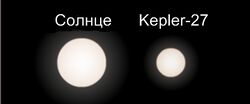Astronomy:Kepler-27
From HandWiki
(Redirected from Astronomy:Kepler-27b)
Short description: G-type star in the constellation Cygnus
| Observation data Equinox J2000.0]] (ICRS) | |
|---|---|
| Constellation | Cygnus[1] |
| Right ascension | 19h 28m 56.81962s[2] |
| Declination | +41° 05′ 09.1405″[2] |
| Apparent magnitude (V) | 15.855[3] |
| Characteristics | |
| Spectral type | G5[4] |
| Astrometry | |
| Proper motion (μ) | RA: 2.171±0.033[2] mas/yr Dec.: −0.324±0.031[2] mas/yr |
| Parallax (π) | 0.9298 ± 0.0281[2] mas |
| Distance | 3,500 ± 100 ly (1,080 ± 30 pc) |
| Details | |
| Mass | 0.9+0.03−0.10[5] M☉ |
| Luminosity | 0.59[3] L☉ |
| Temperature | 5400[3] K |
| Metallicity [Fe/H] | 0.41[3] dex |
| Rotational velocity (v sin i) | 0.6[3] km/s |
| Other designations | |
| Database references | |
| SIMBAD | data |
| KIC | data |
Kepler-27 is a star in the northern constellation of Cygnus, the swan. It is located at the celestial coordinates: Right Ascension 19h 28m 56.81962s, Declination +41° 05′ 09.1405″.[2] With an apparent visual magnitude of 15.855,[3] this star is too faint to be seen with the naked eye.
Planetary system
The planetary system of Kepler-27 comprising two small gas giants on eccentric orbits[5] was discovered in late 2011.[6] The planets Kepler-27b and Kepler-27c have equilibrium temperatures of 610 K and 481 K, respectively.[7] In 2021, a third, sub-Neptune-sized planet was confirmed, orbiting closer in than the other two planets.[8][9]
| Companion (in order from star) |
Mass | Semimajor axis (AU) |
Orbital period (days) |
Eccentricity | Inclination | Radius |
|---|---|---|---|---|---|---|
| d | — | — | 6.54629 | — | — | 0.2414 RJ |
| b | 0.1320±0.018 MJ | 0.118 | 15.3348 | — | — | 0.522±0.024 RJ |
| c | 0.0670±0.011 MJ | 0.191 | 31.3309 | — | — | 0.640±0.029 RJ |
References
- ↑ "Cygnus – constellation boundary", The Constellations, International Astronomical Union, http://www.iau.org/public/constellations/#cyg, retrieved 2011-12-15
- ↑ 2.0 2.1 2.2 2.3 2.4 Vallenari, A. et al. (2022). "Gaia Data Release 3. Summary of the content and survey properties". Astronomy & Astrophysics. doi:10.1051/0004-6361/202243940 Gaia DR3 record for this source at VizieR.
- ↑ 3.0 3.1 3.2 3.3 3.4 3.5 Kepler-27b, NASA Ames Research Center, http://kepler.nasa.gov/Mission/discoveries/kepler30b/, retrieved 2011-12-06
- ↑ Schneider, Jean, Star: Kepler-27, http://exoplanet.eu/star.php?st=Kepler-27, retrieved 2011-12-06
- ↑ 5.0 5.1 Hadden, Sam; Lithwick, Yoram (2017), "Kepler Planet Masses and Eccentricities from TTV Analysis", The Astronomical Journal 154 (1): 5, doi:10.3847/1538-3881/aa71ef, Bibcode: 2017AJ....154....5H
- ↑ Steffen, Jason H.; Fabrycky, Daniel C.; Ford, Eric B.; Carter, Joshua A.; Desert, Jean-Michel; Fressin, Francois; Holman, Matthew J.; Lissauer, Jack J. et al. (2012), Transit Timing Observations from Kepler: III. Confirmation of 4 Multiple Planet Systems by a Fourier-Domain Study of Anti-correlated Transit Timing Variations, doi:10.1111/j.1365-2966.2012.20467.x, Bibcode: 2012MNRAS.421.2342S
- ↑ 7.0 7.1 Furlan, E.; Howell, S. B. (2017), "The Densities of Planets in Multiple Stellar Systems", The Astronomical Journal 154 (2): 66, doi:10.3847/1538-3881/aa7b70, Bibcode: 2017AJ....154...66F
- ↑ Valizadegan, Hamed; Martinho, Miguel J. S. (February 2022). "ExoMiner: A Highly Accurate and Explainable Deep Learning Classifier That Validates 301 New Exoplanets". The Astrophysical Journal 926 (2): 120. doi:10.3847/1538-4357/ac4399. Bibcode: 2022ApJ...926..120V.
- ↑ 9.0 9.1 "Kepler-27". https://exoplanetarchive.ipac.caltech.edu/overview/Kepler-27. Retrieved 7 November 2022.
Coordinates: ![]() 19h 28m 56.825s, +41° 05′ 09.15″
19h 28m 56.825s, +41° 05′ 09.15″
 |


